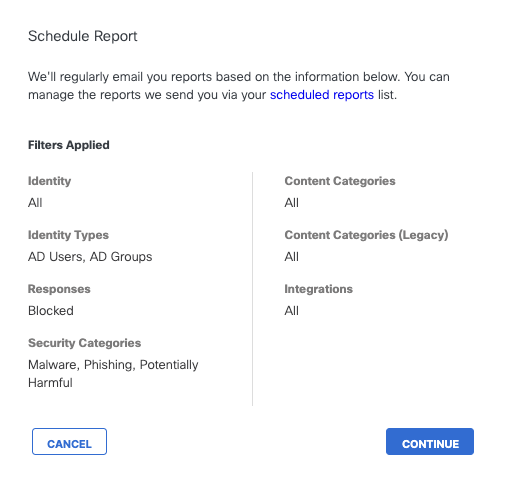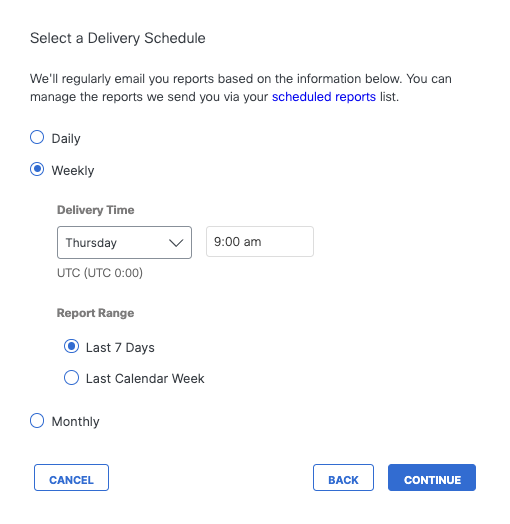Schedule a Report
When scheduling a report, it's important to select filters so that you receive only the data that you want and that your reports don't exceed 10,000 rows—the limit of an emailed report. As well, you want your scheduled report to be digestible and actionable by recipients. If you choose not to add filters, the report will apply to all traffic types for that report across your entire environment and may contain too much data to be readily read and interpreted by the recipient. With scheduled reports, you select filters for the report before you run the Schedule wizard.
Note: Once scheduled, if you do not receive the report, check the spam filter at your mail server gateway—whether it is hosted locally or hosted in the cloud. It's likely that the email was quarantined at that level.
Prerequisites
- Full Admin user role. For more information, see Manage Accounts.
Procedure
- Navigate to Monitor > Reports and select the report you want to schedule.
For a list of schedulable reports, see Report Scheduling. - Select filters for the report and then click Schedule.
Filters are applied to the report and the Scheduling wizard opens.

- Review filters and click Continue.

- Select time parameters to set when and how often you want this report sent to recipients. Click Continue.
For each time period, you can specify a time and range within that time period.
Note: Delivery schedule defaults to the timezone of the user scheduling the report. If additional recipients need reports delivered at a different time, set up additional scheduled reports with the appropriate delivery schedule.
Note: Attempting to schedule a report for a time on the current day, regardless of whether the report is scheduled in the future from the current time on that same day, results in the report being scheduled on the next day at the earliest for weekly and monthly frequencies.

- Give your report a good descriptive name, add email addresses for recipients of this report, and click Save.
Enter as many recipients as you like separating addresses with commas or semicolons.

- Your newly scheduled report is listed at Monitor > Management > Scheduled Reports.
You can update this schedule at any time. For more information, see Update a Scheduled Report.
Check Your Spam Folder
Secure Access uses SparkPost as the service to deliver email. Some mail filters, either at the local level or even at a transport layer (for example, an ISP) may block communications from SparkPost as marketing-related spam. If you do not receive your scheduled reports, check the spam filter at your mail server gateway. Whether your mail server gateway is hosted locally or in the cloud, it's likely the email was quarantined at that level.
Unsubscribe From a Report
You can unsubscribe from a scheduled report at any time by clicking the Unsubscribe link at the bottom of the email.
Report Scheduling < Schedule a Report > Update a Scheduled Report
Updated about 1 month ago
